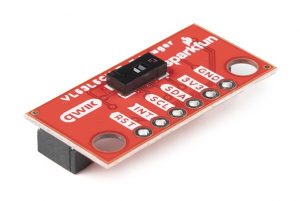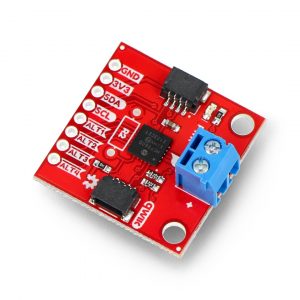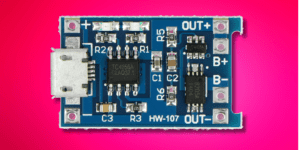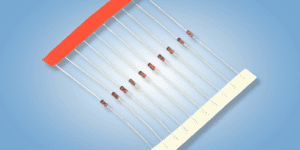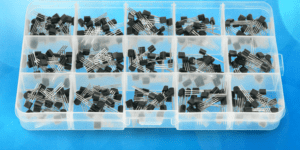Spis treści:
Ah, those SparkFun tiles… In Botland you can find so many different modules that we had to split the articles into several parts! Anyone who knows the manufacturer of red tiles knows that they can be used in almost any project you can think of. If you already know what we wrote about last time, here is another SparkFun review!
Qwiic MP3 Trigger – MP3 player
What would the world be without music? Or even without sound at all? Boring, isn’t it? It is similar to electronic projects – always much more interesting are those that have elements from the “audiovisual” category. And what can we do to enrich the circuit we are building with such possibilities? In the case of playing sound files, we have a solution, and it is called Qwiic MP3 Trigger.
The board supports playback of up to 255 media files from a memory card, which must be inserted into the slot located on its surface. Supported media capacities range from 128 MB to 32 GB. On its surface there is also an MP3 chip WT2003S, a mini Jack connector, a two-pin connector for connecting a speaker and two Qwiic connectors, thanks to which there is no need to solder additional modules to extend the capabilities of the entire installation. Despite this, the manufacturer has also placed on the board soldering fields, if such a solution proves more useful. The choice of what we use is up to us.
The board is based on the ATTiny84 microcontroller, whose task is to handle requests via the I2C interface and support MP3 decoder.
Distance sensor 4000mm
In the previous part of the series of novelties from SparkFun we already wrote what applications the distance sensor can have, so in order not to repeat ourselves, we now present simply its brother with slightly greater capabilities.
The most important element of this module is a digital distance sensor, which measures based on the Time-of-Flight (ToF) method. Its measurement range is 400 cm and is based on the VL53L5CX chip. It integrates a SPAD array, physical infrared filters and diffractive optical elements (DOE), which has a great impact on the measurement efficiency in all lighting conditions. The sensor’s field of view is 63° due to the use of diffractive optical elements on both the transmitter and receiver.
The permissible power supply values for the module extend over a fairly narrow range of 2.7V to 3.3V. This module, like its weaker version, is equipped with two Qwiic connectors, and a number of pins that can also be plugged in to use the board. Communication takes place using the I2C bus.
Distance sensor 4000mm Mini
If you need even more compact components for your project and distance measurement is still the key parameter, nothing lost – the distance sensor described above also has a mini version. Functionality is the same, with a few lost millimetres of size.
Compared to the standard version, there are 3 pins and two mounting holes missing. Qwiic connectors are still available, but they are placed on the other side of the board. The rest of the parameters is the same in both types of this module – sensor, connectors and functionality.
Temperature and humidity sensor
Another sensor in this list, but this time not a distance sensor, but one that measures temperature and humidity. Such sensors and modules are used not only in weather stations – they can also be used in untypical industrial projects or to monitor parameters of e.g. plants in a garden.
The SHTC3 chip used in this case offers humidity measurement in the range from 0 to 100 percent, with an accuracy of ±2 percent RH and a resolution of 0.01°C allows to measure temperature value in the range from -40°C to 125°C with an accuracy of ±0.2°C.
As befits a SparkFun board, the Humidity Sensor Breakout is 25.4mm square and has 4 mounting holes in the corners. It also does not deviate from the standard of having two Qwiic connectors and separate pins for connecting to other modules.
The module accepts supply voltages from 1.62 V to 3.6 V and can be powered either from the Qwiic connectors or via a separate lead-in. Current consumption in normal mode ranges from 4.9 uA to 430 uA and in power-saving mode from 0.5 uA to 270 uA.
Thing Plus board
Small development boards are our favourite area of electronics. Would you ask why? Because we literally have a huge amount of possibilities that can fit in even a closed hand. And so it is with the next proposition from SparkFun on our list. Let’s take a look at the Thing Plus board.
The focal point is the STM32F405 microcontroller with a 32-bit Cortex M4 core with FPU (floating point unit) clocked at 168 MHz. There are 20 GPIO pins (14 with PWM support, up to 15 analogue inputs and 2 analogue outputs), power connectors in the form of a battery with a charging and voltage stabilisation circuit, a JTAG connector, two Qwiic sockets and, of course, a USB-C socket for power and programming.
The board can operate in three modes: sleep, stop and standby. It also has a special debug mode. It is equipped with 1 MB of Flash memory,192 KB of SRAM, including 64 KB of memory coupled to the CCM core, and 128MB of SPI Flash memory. The platform’s supply voltage ranges from 1.8V to 3.6V.
Thermocouple amplifier
Have you ever wondered how you know how hot it is inside a volcano, or how cold it is at the Arctic Pole? How can you measure such values, and which thermometer is capable of doing so?
Such knowledge can be acquired if you have a thermocouple amplifier module like the SparkFun Qwiic Thermocouple Amplifier to use. It can measure temperatures from -200°C to 1350°C, with an accuracy of 1.5°C and a measurement resolution of 0.0625°C. Both the rolling temperature and the temperature of the object under test can be measured with it. We are dealing with large temperature values here, so the module has a function to trigger an alarm at four, freely configurable thresholds. Four pins dedicated to alarms are available for this purpose.
Communication is via the I2C bus as standard. There is also a screw connector for connecting any thermocouple and two Qwiic connectors. The board also has two mounting holes.
Qwiic connector for Raspberry Pi
With Raspberry Pi minicomputers, a lot of projects can already be completed in a basic configuration. However, there are numerous modules that greatly expand the possibilities to be used. Just such an addition is the last item on our news list for today – a tiny module with Qwiic connector for Raspberry Pi.
The SparkFun Qwiic SHIM is placed on the GPIO pins of the Raspberry Pi minicomputer, which correspond to I2C communication. The board with the Qwiic connector is constructed in such a way that despite its use, it is still possible to use other HAT overlays by stacking individual modules.
The SHIM module is also equipped with a 3.3V regulator, which allows you to connect any board equipped with a Qwiic connector. Raspberry boards after applying the overlay will be able to use without any problems all modules included in Qwiic ecosystem known from SparkFun modules.
How useful was this post?
Click on a star to rate it!
Average rating 0 / 5. Vote count: 0
No votes so far! Be the first to rate this post.



